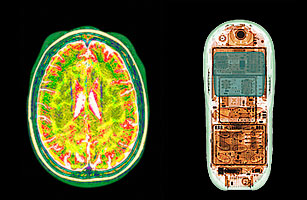
To the surprise of many experts, the IARC classified cell-phone-radiation exposure as 'possibly carcinogenic to humans'
(2 of 2)
The cell-phone industry disagrees. "The IARC classification does not mean cell phones cause cancer," John Walls, vice president of public affairs for the industry group CTIA–the Wireless Association, said in a statement. He noted that the FCC and FDA had largely dismissed any link between cell phones and cancer. And many epidemiologists and radiation researchers were similarly puzzled by IARC's conclusions. The agency admitted that the only links it found between increased cell-phone use and certain kinds of brain tumors were epidemiological — meaning that they were based on case-control studies that followed people with cancer, vs. healthy subjects, and asked how often they had used their phones. But there's still no clear biological explanation — from animal models or anything else — that explains how cell-phone radiation could cause brain tumors. Nor have brain-cancer rates risen in the two decades during which cell phones went from being used by a wealthy few to being used by some 3 billion people around the globe. "To the best of our knowledge, cell-phone radiation does not make use of any of the pathways known to cause cancer," says David Savitz, a Brown University epidemiologist who has studied the environmental causes of cancer. "Everything I've seen points in the opposite direction" of IARC's conclusion.
IARC itself is equivocal about its findings. Specifically, the study found "limited" evidence of a relationship between cell-phone use and glioma and acoustic neuroma, while evidence for other types of cancer was considered inadequate. Limited evidence is slightly more damning than inadequate evidence, but neither is a slam dunk. What's more, while DDT and other nasty things are classified as 2B carcinogens, so are seemingly unthreatening products like pickles and coffee. Most troubling of all, the majority of epidemiological studies done so far are flawed and out of date, including the ones on which the IARC based its report. The freshest data the group was able to use comes from 2004. Think about how much cell phones — and cell-phone habits — have changed in that time.
Given all these reasons to doubt IARC's findings, it would have helped if the researchers had released the details of how they came to the unsettling conclusion they reached, but the full story won't come out until publication in a journal on July 1. Ultimately, IARC's leaders essentially argued that it was better to be safe than sorry at a time when nearly the entire planet is exposed to cell-phone radiation.
"So many people around the world are now using mobile phones," Samet said. "And as use patterns grow, we can anticipate more people using phones longer and longer. What we need is ongoing research and tracking of the way people actually use cell phones."
Even the cell-phone manufacturers can agree with that conclusion and voice no opposition to more research. But it's important to keep the studies independent of the industry and other vested interests, which hasn't been the case so far. When companies bankroll research on their own products, even objective studies can be tainted by the appearance of bias, increasing neither public safety nor public confidence. Davis suggests that a major interdisciplinary research program on bioelectromagnetics be undertaken, funded by a small fee on each handset sold. The National Toxicology Program is already working on what many hope will be the gold standard of animal studies — submitting rats and mice to cell-phone radiation at regular intervals for 20 hours a day. Such total-immersion dosing might help us reach an unambiguous answer.
But chances are just as good that absolute clarity will never happen. What the cell-phone controversy teaches us yet again is that cancer still has its secrets and that it fights to keep them. We'll search for causes wherever we can because the alternative — that we simply can't know why these rare and horrible things happen — is too difficult to bear.